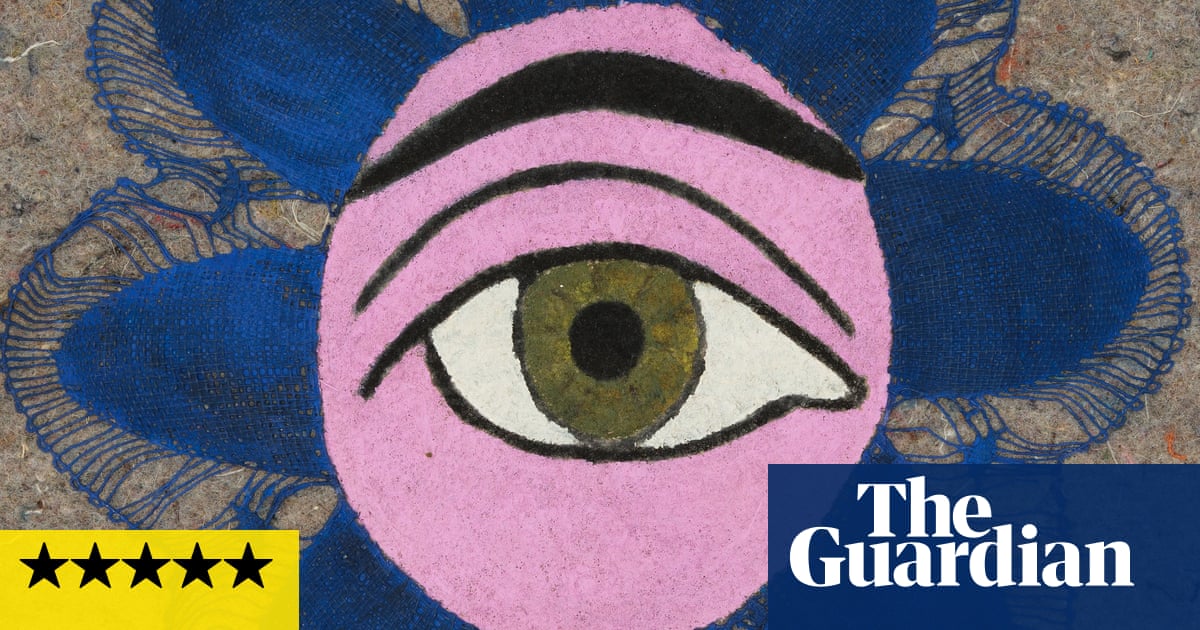
Aneedle piercing an eye, the image sewn with human hair. Another needle through a nipple and a third sewing up the lips to silence them. Detached from the body, human hair can be waste – there’s something abject and awful about hair clogging a sink – and it can be a sentimental keepsake kept in a locket. It can become a thread. You can draw with it or sew with it. In this work, Hong Kong artist Angela Su does both. You need to get up close and you want to step away. She’s giving us something of herself that is filled with pain.
Solange Pessoa’s dropsical, ballooning sacs of earth sag and bulge like bags of guts in a hammock. Magdalena Abakanowicz’s sisal body is suspended from above, as heavy and dark and as cloaked and mysterious as a bat hanging in a cave. A little sewn-up pink woman, by Louise Bourgeois, floats above its shadow, forever falling. Sometimes it is impossible to know what we are looking at: like something between a body part and an item of alien underwear, Xhosa artist Nicholas Hlobo’s Babelana Ngentloko (“they share a head”) trails long tentacle-like ribbons behind a bulging white leather pouch. You could imagine finding this in an aquarium, under a microscope, in a jar in a medical museum or in an exotic lingerie shop. Almost a painting or a relief or a drawing, but not quite any of these things, Hlobo’s work twists itself toward us, as if aware of our presence.
Hybrid, heterodox, filled with strangeness and anger and beauty and horror, Unravel: The Power and Politics of Textiles in Art at the Barbican is often gorgeously excessive, at other moments quiet and private, not giving up its secrets until you linger. It is also filled with stories and materiality, tenderness and violence. This great tangled knot of an exhibition twines the delicate and the intemperate, the flamboyant and funereal, the ancestral and the everyday.
We visit a neighbourhood bodega in Tschabalala Self’s evocations of fast-disappearing Harlem community life, and revisit Tracey Emin’s teenage trauma, in a 1999 appliqued blanket that celebrates her rage and resistance at the experience of being raped as a 13-year-old schoolgirl. There are scenes of traditional Roma life in Poland, and of the spirit world of Haitian Voudu. We swim among the groupers and turtles and rays on Tau Lewis’s coral reef of recycled fabrics, and come across Margarita Cabrera’s green cacti, sewn from US border patrol uniforms, the insignia still visible, by Spanish–speaking immigrants.
Sandwiched under glass and hung at right angles to the gallery wall, LJ Roberts’ small images depict dyke parades and protests following a transphobic attack. We can also see the reverse sides of these embroideries, all the incidental loose and buried threads looping and snaggling and curling in a sort of incidental recognition of the complexity and messiness of relationships. The complexities are more than material. Sheila Hicks asked friends and relatives for their most beloved pieces of clothing, which she then wrapped and decorated with coloured threads, presented as a heap of multicoloured balls in a vitrine, each one enclosing secrets and memories.
Throughout Unravel there are moments when I am stilled, touched and moved by the intimacies the works record. Sewing and embroidering and beading and weaving and the quiet focus that goes into the work’s completion often beg for our own proximity and attendance to the small details. Physical intimacy is often important here. José Leonilson made embroidered texts about life as a queer man with HIV in São Paulo in the early 1990s. Time was running out, but he chose a medium that demanded long periods of concentration. The calm that was necessary to make the work may well have been therapeutic. These are unquiet works. Similarly, Paraguayan artist Feliciano Centurión’s embroidered mixes of text and image look like samplers. “I am a soul in pain,” he wrote in one. “Estoy vivo!” (“I am alive!”) in another. The words arise amid blooming flowers.
Then life crashes in with a roar. In a tapestry by Diedrick Brackens, one black man carries another from a burning building, escaping the flames bursting around them in the gouts of flaring, latch-hooked acrylic yarn that erupt from the surface.
Sometimes we have to get up close and sometimes we’re surrounded. Igshaan Adams takes us on a walk through the hinterlands between two South African townships that had, historically, been deliberately segregated. Using aerial photographs to map these territories of division and exclusion, and the paths people take between them, Adams navigates physical and spiritual proximities and distances. Slender coiling and twisting wires and threads create drifting clouds and dust-devils, spangled with vortices of beads and shells, in a sort of particulate airborne soup that we walk through, as if we’ve kicked up dust going between places and times. Kicking up dust is what Adams does.
All media have their histories, and textiles go back as far as it is possible to go. However you define it, and with its closer definitions as applique or knitting, sewing or stitching, tapestry or embroidery, weaving or quilting, the work here flips between one thing and another – from nature to artifice, image to object, from process to protest, storytelling to commemoration.
Two slabs sit in a room, each like a bier or an autopsy table, lit from below. On each is a textile, filled with images and symbols. One is permeated with the blood of a woman assassinated in Panama City, the other bears bloody handprints and commemorates the killing of Eric Garner while being arrested on Staten Island in 2014. Mexican artist Teresa Margolles made one shroud-like textile in collaboration with a family of Kuna descent, the other with the Harlem Needle arts institute. These communal works ask if wounds can ever heal. Dealing with trauma, anger and possibility of healing, the medium is not the message, but it is a consummate vehicle. To repair and renew, to sew and to weave and to join, to patch and to shroud, are integral to textile art.
There is almost too much to unpick here. This often ravishing, sometimes moving collaboration between the Barbican and the Stedelijk Museum in Amsterdam is one of the best and most thought provoking I have seen on the subject. Call it fibre art or textile art, call it high art or low, do we really care to argue any more whether textiles are craft, applied art or fine art? Call it what you like – textiles here are frequently drawing and sculpting and painting by other means. They are also clothing and rugs and blankets, pictures and maps, totems and abstractions, repositories of history and memory. The exhibition unravels with dyes and blood, pain, pleasure, politics and history. Life and death run through it.
Unravel: The Power and Politics of Textiles in Art is at the Barbican, London, until 26 May












